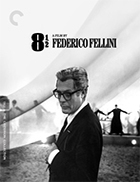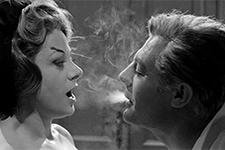| Director: Federico Fellini | | Screenplay: Federico Fellini, Tullio Pinelli, Ennio Flaiano, Brunello Rondi (story by Federico Fellini and Ennio Flaiano) | | Stars: Marcello Mastroianni (Guido Anselmi), Claudia Cardinale (Claudia), Anouk Aimée (Luisa Anselmi), Sandra Milo (Carla), Rossella Falk (Rossella), Barbara Steele (Gloria Morin), Mario Pisu (Mezzabotta), Guido Alberti (Producer), Madeleine LeBeau (French Actress), Jean Rougeul (Writer) | | MPAA Rating: NR | | Year of Release: 1963 | | Country: Italy |  |
|  Federico Fellini's 8½ is inner turmoil externalized in a grand, rambling, fantastical succession of images. Often referred to as the greatest film ever made about filmmaking, it is a wonderfully self-indulgent meditation on creative blocks and personal crises—the film director as tortured soul. The main character, Guido Anselmi (Marcello Mastroianni), is often read as a cinematic surrogate for Fellini, particularly at that moment in his career when he was following his international critical and commercial hit La Dolce Vita (1960), which many consider his greatest film. Like Fellini, Guido has just had a hit movie, and everyone—from his producer, to his writer, to his mistress, to his wife—is surrounding him, expecting something from him, whether it be love or contrition or another hit movie. At the beginning of the film, Guido has escaped to an expensive spa, but even there he is hounded by others (he wakes up to find his writer sitting in his bedroom, waiting for instructions), the constant externalization of the inner pressure he feels. Accepted as a filmmaking genius, he is expected to always be one, which is the albatross around his neck. Much of the film follows a seemingly random course of events in Guido’s life, as he bounces from one confrontation to another, and reality and fantasy constantly blur, calling into question which is which. The film begins in a dream, with Guido’s sense of being professionally trapped perfectly visualized in his being trapped inside a car that is filling with smoke in the midst of a massive traffic jam (people in the cars around him just stare impassively, as if his life-or-death struggle is invisible). The rest of the film is interspersed with fleeting memories of his childhood and far-flung fantasies, including the infamous sequence in which he imagines himself living in a harem with all the women he has ever known and loved. Some scenes mix the realistic and the fantastic, such as a party scene in which a flamboyant mind reader seemingly pulls the thoughts right out of Guido’s head and writes them on a chalkboard. Much of the chaos and pressure of Guido’s life is very, very funny, particularly the irony of his producer (Guido Alberti), who is sinking tons of money into the construction of a giant spaceship set even though Guido has absolutely no idea what he is going to do with it (the towering, skeletal frame of the set, reaching so high, yet looking so empty and pointless, is an apt visual metaphor of Guido’s creative conundrum). There are several poignant scenes between Guido and his estranged wife (Anouk Aimée), a fierce intellectual who despises Guido for his petty infidelities with cheap women. All of this build to a glorious, romantic, carnivalesque conclusion in which Guido, having finally realized that he has been loved, but never truly loved, finds himself surrounded by all the people he has ever known—finally, a possibility of redemption for the tortured artist. The title of the film comes from Fellini’s own life. Prior to making 8½, he had directed seven feature-length films and three shorts; added together, they come out to 8 ½. Yet, it is reductive and ultimately limiting to read Guido as nothing more than Fellini’s projection of himself on screen. There are too many differences between them, the least of which is the utter confidence with which Fellini guided his own career, despite his admittance than he was never entirely sure what he was doing when he made 8½. Nevertheless, 8½ is better read as a projection of the fears, dreams, and desires of not only all filmmakers, but all artists. The act of true creation is a painful process, made all the more so when it becomes blocked, building up pressure that cannot be released. 8½ is like the explosion of all that—a gaudy pastiche of cinematic brilliance that is open to multiple interpretations. It blurs all boundaries, confounds all expectations, ignores all conventions, which is why it is often described as a liberating exercise in pushing the possibilities of modern film. While avant-garde filmmakers had long since broken down the conventions of the classical Hollywood style, Fellini found a way to do the same thing, but coherently, in a way that it could be appreciated by many, but subordinated by none. 8½ is long and somewhat unwieldy, filled as it is with fragments and illusions, yet it is all of one piece. Fellini may have had a deeply personal stake in Guido’s creative confusion, but it is not a dilemma that is evident in this grand achievement. | 8½ Criterion Collection 4K UHD + Blu-ray | | | Aspect Ratio | 1.85:1 | | Audio | Italian Linear PCM 1.0 monaurak | | Subtitles | English | | Supplements | Introduction by filmmaker Terry GilliamAudio commentary by film critics Gideon Bachmann and Antonio MondaFellini: A Director’s Notebook, a short film by Federico FelliniThe Last Sequence, a documentary on Fellini’s lost alternate endingNino Rota: Between Cinema and Concert, a documentary about Fellini’s longtime composerInterviews with actor Sandra Milo, filmmaker Lina Wertmüller, and cinematographer Vittorio StoraroRare photographs from Bachmann’s collectionGallery of behind-the-scenes and production photosTrailerEssay by film critic Stephanie Zacharek | | Distributor | The Criterion Collection | | Release Date | December 10, 2024 | | | COMMENTS | | Criterion’s new 4K presentation of 8½ derives from a 2019 by Istituto Luce - Cinecittà and Centro Sperimentale di Cinematografia - Cineteca Nazionale at the Istituto Luce - Cinecittà laboratories from the original 35mm camera negative, which was made available by RTI-Mediaset and Infinity. The image is utterly superb, a remarkably improvement from the Blu-ray that was included in Criterion’s 2020 Essential Fellini boxset. That image on that disc came from the same restoration, but the move from 2K to 4K boasts notable improvemnets in detail, contrast, and black levels. Gianni di Venanzo’s luminous cinematography has never looked better, and the film’s liminal shifting between fantasy and reality takes on new power. The original monaural soundtrack was restored and remastered in 2020 from various 35mm optical positive and negative elements by the Criterion Collection with restoration by Michael W. Wiese. Like so many European productions of the 1960s, the soundtrack suffers from post-dubbing of most of the dialogue, but nevertheless it sounds as good as I have ever heard it. Fellini makes great use of silence throughout the film, particularly in the opening sequence in which he gradually allows the sound to emerge. Nino Rota’s fabulous musical score (which also incorporates classics such as Wagner’s “Flight of the Valkyries”) sounds excellent for being only a one-channel mix. All but one of the supplements date back to Criterion’s 2001 two-disc DVD, with the exception of The Last Sequence, a 52-minute documentary on Fellini’s lost alternate ending that was previously included on their 2010 Blu-ray and 2020 Essential Fellini boxset. Director Terry Gilliam gets things started with a seven-and-a-half minute video introduction to the film (part of the old Janus Films Director Introduction Series). If you find yourself confounded by Fellini’s mixture of realism and fantasy, a good place to go is the exceptionally insightful screen-specific audio commentary by film critic and Fellini friend Gideo Bachmann and New York University professor of Italian cinema Antonio Monda. The commentary is nicely organized and offers a wide range of viewpoints on both the film and Fellini. Bachmann’s comments offer personal insight into Fellini’s life, while Monda’s commentary is more academic and historical in nature. Woven throughout their commentaries is a formalist audio essay read by actress Tanya Zaicon, although the author of the essay is not made clear. The second disc is packed with several intriguing supplements. The first is Fellini: A Director’s Notebook, a 52-minute experimental “documentary” Fellini directed in 1969 at the behest of NBC producer Peter Goldfarb. It is a bizarre, appropriately “Felliniesque” and self-reflexive exploration of his own status as a filmmaker at that particular moment. It starts amid the beautiful ruins of a film set built for The Voyage of G. Mastorna, a project Fellini never got off the ground, and ends with casting sessions for his next film, Fellini Satyricon, which was eventually completed. Although the print used for the transfer was obviously well worn and badly taken care of—it is scratchy, dirty, and in some instances faded to the point that it looks like it is black and white—it is a fascinating gem that fans of Fellini’s work will treasure. This disc also features Vassili Silovic’s 48-minute documentary Between Cinema and Concert: The Composer Nino Rota, which chronicles the life of Fellini’s favorite composer. The documentary presses the idea that Rota was much more than just a film composer, although his output in that field was astonishing: He wrote scores for 145 movies, at one point writing 12 scores a year. Making good of use of interviews with Rota’s proteges and those with whom he worked, the documentary is effectively organized as a kind of mystery, searching for the truth behind Rota’s too-often-overlooked life and work. There are also three video interviews, which range in length from 17 to 26 minutes, that shed light on both 8½ and Fellini’s work in general. Actress Sandra Milo (who played the role of Carla) and director Lina Wertmüller (Swept Away), who got her start in film by working as an assistant on 8½, speak directly about their experiences working on the film and their personal relationships with Fellini, while cinematographer Vittorio Storano (Apocalypse Now) talks about the lasting legacy of cinematographer Gianni di Venanzo. Lastly, there are two photo galleries. The first, consisting of a handful of shots by Gideon Bachmann, have never before been published. The second gallery, which is much heftier, consists of behind-the-scenes and production photographs, several of which are of scenes that were shot and edited, but never included in the final cut of the film, including an alternate ending. |
Copyright © 2024 James Kendrick Thoughts? E-mail James Kendrick All images copyright © The Criterion Collection |




 (4)
(4)

